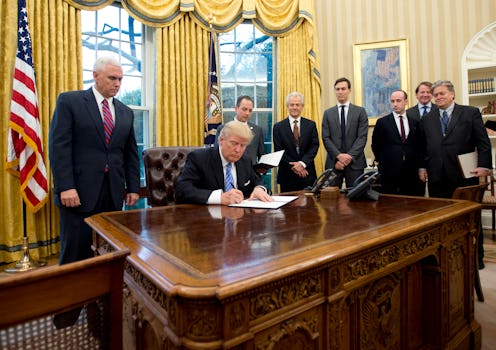News
Why Trump Issued A Flurry Of Executive Orders

Donald Trump has come into office enacting a series of large-scale executive orders, undoing some of President Obama's legacy and enacting some pieces of the Republican agenda quickly, without having to go through the slow process of getting things through Congress. As of right now, he has called for federal agencies to "ease the burden" of the Affordable Care Act (it's still unclear what effect this will have), enacted a temporary hiring freeze on federal workers, pulled the United States out of the Trans-Pacific Partnership, banned funding for international aid organizations that perform or discuss abortions, and resumed work on the the Keystone XL and Dakota Access pipeline projects.
It looks like Trump is moving at a breakneck pace, enacting policies that he and other Republicans have long called for. But Trump is actually spending his first week in roughly the same way as his predecessor, who also used his first week in office to get some of the easy things through and set the tone for the administration. (We can compare different president's executive orders thanks to the data from the American Presidency Project at the University of California, Santa Barbara.)
In President Obama's first week in office, he also enacted five key executive orders. Obama's top priorities at the time were unwinding some of President Bush's excesses during the War on Terror and increasing executive branch transparency. His first five executive orders were:
- Undoing a Bush administration order preventing records of past presidents from being unsealed
- Preventing executive appointees from working as lobbyists for five years after their terms, and preventing lobbyists from getting jobs in the executive branch
- Requiring interrogations by intelligence agencies to comply with U.S. and international law and the Army Field Manual, rescinding all previous executive orders on interrogations
- Ordering the closure of the Guantanamo Bay prison
- Requiring a task force to review the detention of prisoners apprehended in the War on Terror
President Bush entered office at a much less accelerated pace — he only issued two executive orders in the first week, both of them related to creating an office of faith-based initiatives, providing funding to religious and community organizations that provided social services.
President Clinton also had a much lighter load in his first week. He put forward a similar rules for executive appointees regarding lobbying, and formed the National Economic Council, a team of economic advisors to the president that has continued in later White Houses.
There are several reasons that executive orders in the first week have become so much more far-reaching.
The first is that politics has simply gotten more partisan — the goals of both Trump and Obama entering office have been more focused on unwinding the presidencies of their predecessors than in the cases of Bush and Clinton.
But just as big of a reason is the way that the use of executive orders has changed. President Obama, though he did not use more executive orders than other presidents, made more far-reaching ones than his predecessors. Most notably, Obama did so by starting the Deferred Action for Childhood Arrivals program for undocumented immigrants with the stroke of a pen.
Trump's spree of executive orders is the other side of Obama's coin. He's taking advantage of the precedent set by Obama, using the absolute maximum of presidential power without waiting for Congress. This allows him to both undo Obama orders quickly and to try to enact more policy quicker.
Trump seems to be taking advantage of the maximum power the executive can wield without Congress's help, just as Obama did. Don't be surprised if the next president, upon taking office, does something similar.